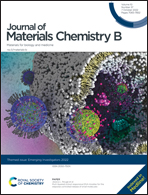Biofunctionalized metal–organic frameworks and host–guest interactions for advanced biomedical applications
Abstract
Owing to highly favourable properties such as enormous internal surface areas, high porosity and large flexibility, when it comes to the choice of precursors and high control over their structures and porosity, metal–organic frameworks (MOFs) have emerged as promising materials for applications such as gas storage and separation, catalysis, wastewater filtration, etc. The applications of MOFs, despite being so lucrative materials, are very limitedly explored in biomedical applications owing to several concerns such as their biocompatibility, rate of degradation and rate of accumulation in tissues and biological systems. Newer methods are being developed to make MOFs more biologically palatable by their surface functionalization using biomolecules such as nucleic acids, amino acids and lipids. Here we present the progress in biofunctionalization methods of MOFs for improving their physical and chemical properties for biomedical applications, with special focus on their formation via covalent and non-covalent routes. Following this, we discuss in detail the applications of these biofunctionalized MOFs in areas of drug delivery, bio-sensing and bio-imaging. We conclude by presenting a brief outlook of the major challenges that lie ahead for mainstream usage of these materials for advanced biomedical applications.

- This article is part of the themed collection: Journal of Materials Chemistry B Emerging Investigators


 Please wait while we load your content...
Please wait while we load your content...